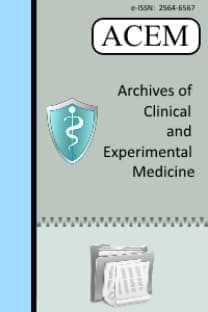Semptomatik hepatik hemanjiomlarda cerrahi tedavi deneyimi
hepatik hemanjiom, karaciğer rezeksiyonu, enükleasyon
Experience in surgical treatment of symptomatic hepatic hemangiomas
hepatic hemangioma, liver resection, enucleation,
___
- 1. Belghiti J, Dokmak S, Vilgrain V, Paradis V. Benign liver lesions. Blumgart's Surgery of the Liver, Pancreas and Biliary Tract: Elsevier; 2012. p. 1250-67.
- 2. Adam YG, Huvos AG, Fortner JG. Giant hemangiomas of the liver. Ann Surg. 1970;172:239.
- 3. Herman P, Costa ML, Machado MAC, Pugliese V, D'Albuquerque LAC, Machado MCC, et al. Management of hepatic hemangiomas: a 14-year experience. J Gastrointest Surg. 2005;9:853-9.
- 4. Adhikari DR, Thakur V, Telavane PP, Kulkarni R, Singh R, Joshi RM. Hypergiant hepatic hemangiomas: case series. Indian J Surg. 2015;77:40-2.
- 5. Özden İ, Poyanlı A, Önal Y, Demir AA, Hoş G, Acunaş B. Superselective transarterial chemoembolization as an alternative to surgery in symptomatic/enlarging liver hemangiomas. World J Surg. 2017;41:2796-803.
- 6. Hasan HY, Hinshaw JL, Borman EJ, Gegios A, Leverson G, Winslow ER. Assessing normal growth of hepatic hemangiomas during long-term follow-up. JAMA Surg. 2014;149:1266-71.
- 7. Iwatsuki S, Starzl TE. Personal experience with 411 hepatic resections. Ann Surg. 1988;208:421.
- 8. Iwatsuki S, Todo S, Starzl TE. Excisional therapy for benign hepatic lesions. Surg Gynecol Obstet. 1990;171:240.
- 9. Özden İ, Emre A, Alper A, Tunacı M, Acarlı K, Bilge O, et al. Long-term results of surgery for liver hemangiomas. Arch Surg. 2000;135:978-81.
- 10. Pietrabissa A, Giulianotti P, Campatelli A, Di Candio G, Farina F, Signori S, et al. Management and follow-up of 78 giant haemangiomas of the liver. Br J Surg. 1996;83:915-8.
- 11. Singh RK, Kapoor S, Sahni P, Chattopadhyay TK. Giant haemangioma of the liver: is enucleation better than resection? Ann R Coll Surg Engl. 2007;89:490-3.
- 12. Brouwers M, Peeters P, De Jong K, Haagsma E, Klompmaker I, Bijleveld C, et al. Surgical treatment of giant haemangioma of the liver. Br J Surg. 1997;84:314-6.
- 13. Gedaly R, Pomposelli JJ, Pomfret EA, Lewis WD, Jenkins RL. Cavernous hemangioma of the liver: anatomic resection vs enucleation. Arch Surg. 1999;134:407-11.
- 14. Hamaloglu E, Altun H, Ozdemir A, Ozenc A. Giant liver hemangioma: therapy by enucleation or liver resection. World J Surg. 2005;29:890-3.
- 15. Lerner SM, Hiatt JR, Salamandra J, Chen PW, Farmer DG, Ghobrial RM, et al. Giant cavernous liver hemangiomas: effect of operative approach on outcome. Arch Surg. 2004;139:818-23.
- 16. Borgonovo G, Razzetta F, Arezzo A, Torre G, Mattioli F. Giant hemangiomas of the liver: surgical treatment by liver resection. Hepatogastroenterology. 1997;44:231-4.
- 17. Belli L, De Carlis L, Beati C, Rondinara G, Sansalone V, Brambilla G. Surgical treatment of symptomatic giant hemangiomas of the liver. Surg Gynecol Obstet. 1992;174:474-8.
- 18. Hu M, Chen K, Zhang X, Li C, Song D, Liu R. Robotic, laparoscopic or open hemihepatectomy for giant liver haemangiomas over 10 cm in diameter. BMC Surg. 2020;20:1-10.
- 19. Srivastava D, Gandhi D, Seith A, Pande G, Sahni P. Transcatheter arterial embolization in the treatment of symptomatic cavernous hemangiomas of the liver: a prospective study. Abdom Imaging. 2001;26:510-4.
- 20. Giavroglou C, Economou H, Ioannidis I. Arterial embolization of giant hepatic hemangiomas. Cardiovasc Intervent Radiol. 2003;26:92-6.
- 21. Tak WY, Park SY, Jeon SW, Cho CM, Kweon YO, Kim SK, et al. Ultrasonography-guided percutaneous radiofrequency ablation for treatment of a huge symptomatic hepatic cavernous hemangioma. J Clin Gastroenterol. 2006;40:167-70.
- ISSN: 2564-6567
- Yayın Aralığı: 3
- Başlangıç: 2016
- Yayıncı: -
Umut Percem ORHAN SOYLEMEZ, Başak ATALAY, Nesrin GÜNDÜZ
Hülya AYIK AYDIN, Mehmet Esat DUYMUŞ
Bir COVID-19 hastasında sialadenit ve tiroiditin atipik birlikteliği: Bir olgu sunumu
Deniz İNCAMAN, Gamze Gül GÜLEÇ
Tüm apendektomi örneklerinin histopatolojik olarak değerlendirilmesi gerekli midir?
Mustafa Ömer YAZICIOĞLU, Mustafa DÖNMEZ
Müjdat UYSAL, Işın DOĞAN EKİCİ, İlknur BİNGÜL, Canan KÜÇÜKGERGİN, A. Fatih AYDIN, Semra DOĞRU ABBASOĞLU
Mevlüt Recep PEKCİCİ, Marlen SÜLEYMAN, Koray KOŞMAZ, Mehmet ŞENES, Özlem TANAS IŞIKÇI, Abdullah ŞENLİKÇİ, İknur ALKAN KUSABBİ, Yılmaz ÜNAL, Yusuf Murat BAĞ, Sema HÜCÜMENOĞLU
Abdullah ŞENLİKCİ, Koray KOŞMAZ, Abdullah DURHAN, Marlen SÜLEYMAN, Yusuf Murat BAG, Mevlüt Recep PEKCİCİ, Mehmet ŞENEŞ, İlknur ALKAN KUŞABBİ, Ozlem TANAS ISIKCI, Yılmaz ÜNAL, Sema HÜCÜMENOĞLU
An atypical co-existence of sialadenitis and thyroiditis in a COVID-19 patient: A case report
Gamze Gül GÜLEÇ, Deniz İNCAMAN
Türk popülasyonunda primer glenohumeral osteoartrit sınıflaması – morfolojik çalışma
Gökay EKEN, Turan Bilge KIZKAPAN, Mustafa ÖZÇAMDALLI, Erdal UZUN, Sinan OĞUZKAYA
Tavşanlarda spinal lomber füzyon için otogreft ve DBM Flex'in (Grafton) deneysel karşılaştırması
